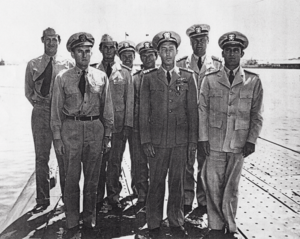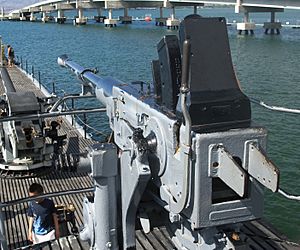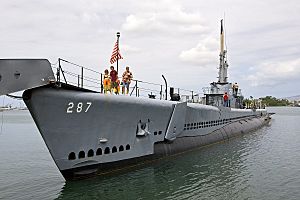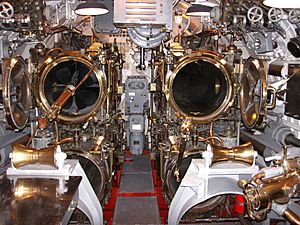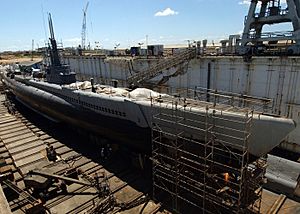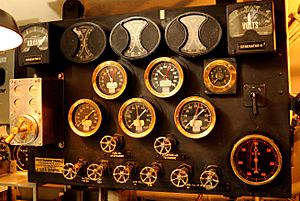USS Bowfin facts for kids

|
|
| History | |
|---|---|
| Namesake | Bowfin |
| Builder | Portsmouth Naval Shipyard, Kittery, Maine |
| Laid down | 23 July 1942 |
| Launched | 7 December 1942 |
| Sponsored by | Mrs. Jane Gawne, wife of Captain James Gawne |
| Commissioned | 1 May 1943 |
| Decommissioned | 12 February 1947 |
| Recommissioned | 27 July 1951 |
| Decommissioned | 22 April 1954 |
| Recommissioned | 10 January 1960 |
| Decommissioned | 1 December 1971 |
| Stricken | 1 December 1971 |
| Status | Museum ship in Pearl Harbor, Hawaii since 1 August 1979 |
| Badge | 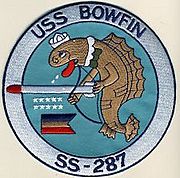 |
| General characteristics | |
| Class and type | Balao-class diesel-electric submarine |
| Displacement | |
| Length | 311 ft 9 in (95.02 m) |
| Beam | 27 ft 3 in (8.31 m) |
| Draft | 16 ft 10 in (5.13 m) maximum |
| Propulsion |
|
| Speed |
|
| Range | 11,000 nautical miles (20,000 km) surfaced at 10 knots (19 km/h) |
| Endurance |
|
| Test depth | 400 feet (120 m) |
| Complement | 10 officers, 70–71 enlisted |
| Armament |
|
|
USS Bowfin (submarine)
|
|
| Location | 11 Arizona Memorial Dr., Honolulu, Hawaii |
| Built | 1942 |
| Architect | Portsmouth Navy Yard |
| NRHP reference No. | 82000149 |
| Significant dates | |
| Added to NRHP | 16 November 1982 |
| Designated NHL | 14 January 1986 |
The USS Bowfin (SS/AGSS-287) is a famous Balao-class submarine of the United States Navy. It was named after the bowfin fish. This submarine played a big role in World War II.
Since 1981, the Bowfin has been a museum ship in Pearl Harbor, Hawaii. It is part of the USS Bowfin Submarine Museum & Park. You can find it right next to the USS Arizona Memorial Visitor Center.
The Bowfin was built at the Portsmouth Naval Shipyard in Kittery, Maine. Its construction started on July 23, 1942. It was launched on December 7, 1942, and officially joined the Navy on May 1, 1943. Commander Joseph H. Willingham was its first captain.
Contents
- First War Patrol Adventures
- Second War Patrol Missions
- Third War Patrol Challenges
- Fourth War Patrol Encounters
- Fifth and Sixth War Patrols
- Seventh Through Ninth War Patrols
- Post-War Service and Museum Life
- Enemy Ships Sunk by Bowfin
- The Tsushima Maru Sinking Event
- USS Bowfin Submarine Museum & Park
- See also
First War Patrol Adventures
After getting ready, the submarine traveled to New London, Connecticut, for training. In July 1943, it headed to the Pacific Ocean for the war. After crossing the Panama Canal, it reached Australia.
On August 25, the Bowfin began its first war patrol. It sailed into the Mindanao Sea but didn't find many targets at first. On September 24, it teamed up with another submarine, the USS Billfish.
Tracking Enemy Ships
The next day, the two submarines found a group of six enemy ships. The Bowfin chased them for five hours to get into a good position. It then fired six torpedoes. Three hit a cargo ship, and two hit a transport ship.
The submarine quickly turned and fired four more torpedoes at a tanker. Its crew heard explosions but had to dive deep to avoid enemy gunfire. When it surfaced later, a large passenger-cargo ship, the Kirishima Maru, was sinking. The tanker was on fire, and the transport ship seemed to be sinking.
More Action and a Return to Port
Later, the Bowfin sank a barge carrying over 100 Japanese soldiers using its four-inch gun. It also sank a schooner with gunfire. The Bowfin finished its first successful patrol on October 10, arriving in Fremantle. Its captain, Commander Willingham, was praised for the submarine's great performance.
Second War Patrol Missions
The Bowfin started its second patrol on November 1, heading for the South China Sea. It worked with the Billfish again. On November 8, the Bowfin found five schooners. It sank three with its four-inch gun before enemy planes forced it to dive.
Later, it sank another large sailing ship. Two days after that, it found two small steamers and set them on fire with gunfire.
Surprise Attacks and Damage
On November 26, during a rainstorm near Indochina, the Bowfin suddenly found itself surrounded by Japanese ships. It barely avoided hitting a tanker. It then fired torpedoes, sinking the tanker Ogurasan Maru and the cargo ship Tainan Maru.
A few hours later, it sank another small ship called Van Vollenhoven. On November 28, the Bowfin joined the Billfish to attack a convoy. They quickly sank the cargo ship Sydney Maru and the tanker Tonon Maru.
During this battle, the Bowfin was hit by enemy fire, causing leaks. Despite the damage, it fired its last two torpedoes. The submarine then headed back to Australia for repairs. On the way, it destroyed a "two-masted yacht" with its deck gun. The Bowfin arrived in Fremantle a week later, again praised for its amazing patrol.
Third War Patrol Challenges
The submarine began its third war patrol on January 8, 1944. It sailed through several seas to the Makassar Strait. On January 16, it sank a small schooner with its deck gun. The next day, it found a cargo ship and two escort ships.
Its torpedoes had problems, but one hit and stopped the cargo ship. The Bowfin returned the next day and finished off the damaged cargo ship, the Shoyu Maru, with four torpedoes. It also hit one of the escort ships.
Admiral on Board
The Bowfin went to Darwin for more torpedoes. While there, Rear Admiral Ralph Waldo Christie came aboard. He wanted to see how the torpedoes worked and learn about the Bowfin's success.
The day after returning to sea, the submarine hit a small cargo ship with three torpedoes. On January 28, the Bowfin chased a large tanker. It fired many torpedoes, hitting the tanker several times and causing fires. The tanker fought back, but the Bowfin kept attacking. The tanker eventually got away.
The next day, the Bowfin placed mines in Makassar Strait. On January 30, it destroyed two small schooners with its four-inch gun. The submarine returned to Fremantle on February 5.
Fourth War Patrol Encounters
The Bowfin left on February 28, 1944, heading for the Celebes Sea. On March 10, its crew saw a convoy of four ships with two escorts. The Bowfin fired six torpedoes, but four exploded too early. Japanese planes forced the submarine to dive.
During the attack, enemy ships dropped depth charges, shaking the Bowfin badly. When it surfaced, a cargo ship was damaged and being towed. The Bowfin attacked again, sinking the Tsukikawa Maru with four torpedoes.
More Torpedo Attacks
The submarine then looked for the rest of the convoy. It caught up after dark and fired its remaining torpedoes, but none hit. It went back to Darwin for more torpedoes. Three days later, it attacked a small convoy, but all its torpedoes missed.
On March 24, the Bowfin attacked a five-ship convoy in the Celebes Sea. It sank two cargo ships: the Sinkyo Maru and the Bengal Maru. It also damaged a third ship but ran out of torpedoes. The submarine returned to Darwin on April 1.
Fifth and Sixth War Patrols
Commander John H. Corbus took over command of the submarine. The Bowfin left on April 24 for its sixth patrol, heading for the Palaus. This was its longest patrol, but it only managed to hit one cargo ship that didn't sink. It also helped rescue downed pilots before heading to Pearl Harbor, arriving on June 21.
On July 16, the Bowfin left Hawaii for the Ryukyu Islands. On August 9, it found four ships heading into the harbor at Minami Daito. It followed them and fired torpedoes, blowing up two ships and damaging a third. One torpedo even hit a dock, sending a bus into the water! This event was later included in the 1959 comedy film Operation Petticoat.
The Tsushima Maru Incident
On August 22, near the Tokara Islands, the Bowfin attacked a convoy. It hit several ships, including the transport ship Tsushima Maru, which sank. The Tsushima Maru was carrying many civilians, including hundreds of schoolchildren, who were being evacuated from Okinawa. Sadly, many lives were lost in this tragic event.
On August 28, the Bowfin set a trawler on fire with its four-inch gun. After using its last torpedoes, the submarine headed back to the US West Coast. It arrived in San Francisco, California, on September 21 for repairs.
Seventh Through Ninth War Patrols
After repairs, Commander Alexander K. Tyree became the new captain on December 16, 1944. The submarine sailed back to the Pacific. It performed lifeguard duty near Japan, rescuing American pilots whose planes had crashed.
On February 17, the Bowfin attacked two Japanese subchasers. It sank the Coast Defense Vessel No. 56 with torpedoes. It survived a 26-depth-charge attack from the other subchaser. The submarine later sank a Japanese sea truck.
Rescuing Downed Pilots
On March 19, the Bowfin rescued two airmen, Lieutenant R. U. Plant and J. Papazoglakis, from a downed Grumman TBF Avenger torpedo bomber. Their plane had been hit by enemy fire during a bombing run. The submarine quickly brought them aboard to safety. It then continued its patrol. The Bowfin ended this patrol in Guam on March 25.
Its eighth patrol began on April 23, north of Honshū and Hokkaidō. On May 1, it sank the transport ship Chowa Maru. A week later, it sank the cargo ship Daito Maru No. 3. After searching for more targets, it returned to Guam for refit.
For its ninth and final patrol of the war, the Bowfin first rescued a Marine Corps pilot whose fighter plane had crashed. On May 29, it headed for Japan. It was one of nine submarines sent into the Sea of Japan using new mine-detecting sonar. It navigated through minefields in Tsushima Strait. On June 11, it sank the cargo ship Shinyō Maru No. 3. On June 13, it sank another cargo ship, the Akiura Maru.
The submarine left the Sea of Japan and headed for Hawaii. It reached Pearl Harbor on Independence Day. In early August, the Bowfin sailed for the Marianas for its 10th patrol. However, it received news that Japan had surrendered, ending World War II. The Bowfin returned to Hawaii and then sailed to the east coast of the United States. It arrived in Tompkinsville, New York, on September 21, 1945. It then served in the Atlantic Fleet before being put into reserve on February 12, 1947.
Post-War Service and Museum Life
The Bowfin was brought back into service on July 27, 1951, during the Korean War. It sailed to the Pacific and worked from San Diego, California, for two years, doing training exercises. When the Korean War ended, the Navy needed fewer active submarines. The Bowfin was put back into reserve on April 22, 1954.
In 1960, it moved to Seattle, Washington, to become a training submarine for the Naval Reserve. It served there for over ten years. The Bowfin was officially removed from the Navy list on December 1, 1971. It was then taken back to Pearl Harbor, where it now serves as a memorial.
The Bowfin was named a National Historic Landmark in 1986. It has been in drydock several times for restoration, including in 1987, 2004, and 2022. In 1987, it was used as a filming location for the miniseries War and Remembrance.
Enemy Ships Sunk by Bowfin
- The passenger-cargo ship Kirishima Maru on September 25, 1943
- The tanker Ogurasan Maru and cargo ship Tainan Maru on November 26, 1943
- The cargo ship Van Vollenhoven on November 26 or 27, 1943
- The passenger-cargo ship Sydney Maru and the tanker Tonan Maru on November 28, 1943
- Two schooners destroyed with its four-inch gun on November 30, 1943
- The cargo ship Shoyu Maru on January 17, 1944
- The cargo ship Tsukikawa Maru on March 10, 1944
- The cargo ships Shinkyo Maru and Bengal Maru on March 24, 1944
- The passenger-cargo ship Tsushima Maru on August 22, 1944
- The frigate Coastal Defense Vessel No. 56 on February 17, 1945
- The auxiliary patrol boat Chōkai Maru on March 2, 1945
- The passenger-cargo ship Chowa Maru on May 1, 1945
- The cargo ship Daito Maru No. 3 on May 8, 1945
- The cargo ship Shinyō Maru No. 3 on June 11, 1945
- The cargo ship Akiura Maru on June 13, 1945
The Tsushima Maru Sinking Event
The Tsushima Maru was a Japanese cargo ship that the Bowfin sank on August 22, 1944. This ship was carrying hundreds of schoolchildren and other civilians from Okinawa to Kagoshima. The ship was part of a convoy when it was attacked. It sank near the island of Akusekijima. Many lives were lost in this sad event, including a large number of schoolchildren.
During its sixth patrol, the Bowfin also destroyed a pier at Minami Daito that had a crane and a bus. The submarine also sank thirteen small vessels using its deck guns.
USS Bowfin Submarine Museum & Park
The Pacific Fleet Submarine Memorial Association owns and runs the Bowfin. It is now a key part of the USS Bowfin Submarine Museum & Park in Pearl Harbor, Hawaii. Visitors can take a tour of the submarine. An audio guide tells you what life was like inside the vessel during World War II.
The museum at the park has many exhibits and artifacts. These show the history of submarines and the United States Submarine Service. You can see detailed models, weapon systems, photos, paintings, and battle flags. There is also a special memorial. It honors the 52 American submarines and over 3,500 submariners who were lost during World War II.
Other cool exhibits at the museum include a Kaiten torpedo and a 40-mm quad gun. You can also see Poseidon C-3 and Regulus I missiles. The park is close to the visitor center for the USS Arizona Memorial. It is also across the harbor from the Battleship Missouri Memorial.
See also



